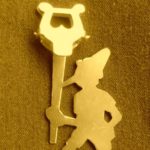City of Stars
Tagged: Suzuki Hammond 44H
- This topic has 16 replies, 4 voices, and was last updated 5 years, 7 months ago by
 Joanna Funk.
Joanna Funk.
-
AuthorPosts
-
September 8, 2018 at 2:35 pm #10257
 Joanna FunkParticipant
Joanna FunkParticipantCity Of Stars melodica and piano
When I first bought the Hammond 44 I was keen to play the lower notes. But this is from the mid-range upward. The piano is minimal, melodica’s the star! In the original song there’s a small bit where two voices duet, so I decided to play two-note chords on the melodica for that part, rather than record a separate track. Listening back I think recording a second “voice” would have sounded gentler. It was hard to control the sound. One day I’d like to try to blow chords to sound a bit like a harmonica. Hope you like it. Cheers.
September 8, 2018 at 3:16 pm #10258 Gianluca BarbaroParticipant
Gianluca BarbaroParticipantVery nice, Joanna!
September 8, 2018 at 5:38 pm #10259 Alan BrintonParticipant
Alan BrintonParticipantOh, that is so lovely. I was just thinking of you while working on “It never entered my mind,” Joanna. One of the things I love about your style is that it gives me hope by being so good without a whole lot of fancy footwork.
September 8, 2018 at 5:42 pm #10260 Alan BrintonParticipant
Alan BrintonParticipantBut now I see that your “It never entered my mind” is no longer available, so I guess it’s too late for me to steal it.
September 8, 2018 at 7:41 pm #10261 Joanna FunkParticipant
Joanna FunkParticipantThank you Gianluca and Alan!
Alan, yes simplicity is definitely the way I want to go too. I did some blog housekeeping, let me find It Never Entered My Mind for you.
September 9, 2018 at 12:19 am #10262 Joanna FunkParticipant
Joanna FunkParticipantHi Alan. I found it and have uploaded here. Gosh it’s so low! 🙂
It Never Entered My MindBy the way, I liked that website you linked to, in the thread about Hermeto Pascoal’s music. I downloaded the chart for Chet Baker’s “Let’s Get Lost”. TQ
September 9, 2018 at 12:34 am #10263 Alan BrintonParticipant
Alan BrintonParticipantThanks, Joanna.
September 9, 2018 at 6:52 am #10264 Joanna FunkParticipant
Joanna FunkParticipantI did a second version of the song. Some things were irritating me. Here is is.
This time I placed the laptop where I could see it when playing the piano part, so I could watch the melodica track and know when it was about to start its next phrase. The hazard of not playing to a metronome, I suppose. Also, I played the duet as two tracks, and played the male voice an octave lower. I think it sounds nicer. Still plenty of stumbling notes, but the one real edit I did was near the end, I flipped a page badly and there was a long gap in the melodica solo, but I didn’t want to redo it, so I played the piano part to the same big gap, and cut out a chunk of gap afterwards. That’s it from me. Promise!
September 9, 2018 at 10:29 am #10265 Gianluca BarbaroParticipant
Gianluca BarbaroParticipantHi Joanna, I agree, this version is nicer than the previous one (which was already very nice!).
May advise you to add some reverb to your recordings? It depends on the recording software you are using, but it should not be difficult and it would make the sound richer and more contextualized. Also, if available, a little compression probably would help.
September 9, 2018 at 12:28 pm #10266 Joanna FunkParticipant
Joanna FunkParticipantHi Gianluca, thank you so much for your advice. I will have to read about reverb and compression. My recording software is Studio One which came with my PreSonus AudioBox interface. Once I could record separate tracks and export the mixdown as a wav file, I stopped learning about anything else (which I know is bad). I edit the wav file using NCH Mixpad, the extent of my edit is: Split, Delete, Fade In & Out, and Amplify. I know it could all be done (and so much more) in StudioOne. Up till now all I have cared about is playing the instrument – improving breath control for better expression and phrasing, and playing accurately, especially finding the notes farthest away from my face which I can’t see. I still blow directly into the melodica with no mouthpiece, and feel over the black notes to find the white ones. But it makes sense to record well, as long as it’s a fair representation of what I sound like. From your other comments in this space, I know you believe in honest representation of one’s work ?! More homework for me then. Thank you again, Gianluca.
September 9, 2018 at 2:48 pm #10267 DarenKeymaster
DarenKeymasterAnd there I was thinking that you chose to do away with reverb and any processing, as a production decision! I think it does add to your simple, direct, innocent expression, which I a find a joy to listen to. But yes, I agree its worth learning how to add some reverb – you’ll be amazed at how transformative it can be.
I see you were able to have the harmony notes at a lower volume by recording 2 tracks separately. Thats one of the quirks of melodicas, the lowest note of a chord is loudest, and dominates when sometimes we need it to be under the melody.
Do you work with midi Joanna? If not, its another great thing to learn. You can record the piano part in free time, and then edit out any wrong notes, or gaps. You can then use another track to record a new click track along with the piano, which speeds up and slows down according to the piano track. That way, when you record melodica, you can listen to the piano and metronome at the same time. There’ll be no surprises, and when you bounce, you take the metronome back out
September 9, 2018 at 4:00 pm #10268 Gianluca BarbaroParticipant
Gianluca BarbaroParticipantJoanna, when we record an instrument we generally put the microphone very near it. This way, we loose part of the natural reverberation of the room we are playing in: in my opinion, the digital reconstruction of the (lost) ambience is not dishonest at all 🙂
The compression might be a different case and it refers to a well-known psycho-acoustical phenomenon: the louder the music is, the more we are emotionally involved. If you google “loudness war”, you will see how exploited this circumstance has been in the last few years by commercial music.
In home productions, a light compression can help the recording be a little more effective, without actually editing anything of your performance. So, maybe it is a little bit of a cheating on the psychological level, but it doesn’t alter what you have played.Daren, true that the lowest notes of a chord are loudest, but I have noticed that this can be (again, psycho-acoustically) corrected by keeping the lowest notes shorter. It is technically challenging (we have to articulate differently the various notes of the chord) but it seems effective. This is an old “trick” used when playing polyphonic music that could be applied to the melodica as well, I guess… Can you confirm this?
September 9, 2018 at 4:32 pm #10270 DarenKeymaster
DarenKeymasterthe lowest notes of a chord are loudest, but I have noticed that this can be (again, psycho-acoustically) corrected by keeping the lowest notes shorter
Yes, or can be played as ‘grace notes’ – very short notes played just before the main note, which give a sense of the harmony. I enjoy working with some of these melodica characteristics. I see it as an instrument which really excels at monophonic playing. When composing or arranging, I like to find ways of implying the harmony through the melody. I find this approach works really well with Irish traditional music and solo Bach, both of which rely on a monophonic instrument providing the whole hormonic experience, so to speak.
September 9, 2018 at 7:43 pm #10275 Joanna FunkParticipant
Joanna FunkParticipantHi Daren, for me, beauty in simplicity is always the way, but all the advice given so generously here doesn’t take away from that!
I have seen how useful editing with midi is, and I can definitely start using that.
In this song, I deliberately recorded melodica first, and without a metronome. I wanted the pianist to accompany the singer, so to speak. However, with no real, physical singer, there’s no one for the pianist to watch – and she’s singing rubato! It really surprised me what a difference that made, and how hard it was for the piano to accompany the melodica. Maybe the melodica needs to listen to a piano (played with metronome), and melodica plays freely, within that framework, and then the piano accompanies the melodica, again, afterwards. I hope that made sense.
What is bounce, Daren?
Gianluca – thank you for explaining reverb and compression. Yes I would love to recapture the essence of playing in a spacious room, and enhance the dynamic a little! I will read up about it.
Very interesting about the low notes being loudest in a chord. I can’t imagine how to hold the low note less, I’ll have to try it.
Homework indeed! You guys are the best!!! ?
September 9, 2018 at 11:18 pm #10278 Joanna FunkParticipant
Joanna FunkParticipantOkay I just came across “bounce” in a midi article. Right folks, I’ll report back in a few weeks, with a result to upload, hopefully! Can’t wait. TQ!
-
AuthorPosts
- You must be logged in to reply to this topic.
